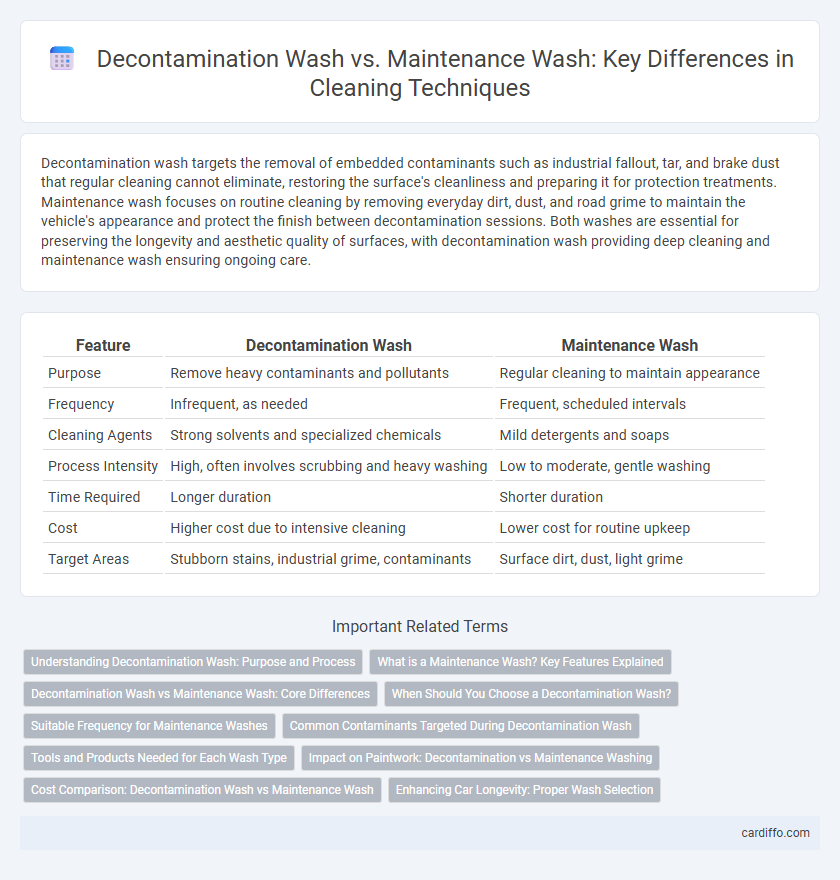Decontamination wash targets the removal of embedded contaminants such as industrial fallout, tar, and brake dust that regular cleaning cannot eliminate, restoring the surface's cleanliness and preparing it for protection treatments. Maintenance wash focuses on routine cleaning by removing everyday dirt, dust, and road grime to maintain the vehicle's appearance and protect the finish between decontamination sessions. Both washes are essential for preserving the longevity and aesthetic quality of surfaces, with decontamination wash providing deep cleaning and maintenance wash ensuring ongoing care.
Table of Comparison
| Feature | Decontamination Wash | Maintenance Wash |
|---|---|---|
| Purpose | Remove heavy contaminants and pollutants | Regular cleaning to maintain appearance |
| Frequency | Infrequent, as needed | Frequent, scheduled intervals |
| Cleaning Agents | Strong solvents and specialized chemicals | Mild detergents and soaps |
| Process Intensity | High, often involves scrubbing and heavy washing | Low to moderate, gentle washing |
| Time Required | Longer duration | Shorter duration |
| Cost | Higher cost due to intensive cleaning | Lower cost for routine upkeep |
| Target Areas | Stubborn stains, industrial grime, contaminants | Surface dirt, dust, light grime |
Understanding Decontamination Wash: Purpose and Process
Decontamination wash targets the removal of stubborn contaminants such as grease, oils, and chemical residues that regular maintenance washes cannot eliminate. This process involves specialized cleaning agents and techniques designed to penetrate deep layers of dirt, ensuring thorough purification of surfaces. Understanding the distinct purpose of decontamination wash helps maintain hygiene standards and prolong the lifespan of equipment or vehicles.
What is a Maintenance Wash? Key Features Explained
A maintenance wash is designed to preserve surface cleanliness and protect finishes by removing everyday dirt, grime, and contaminants without the need for intensive cleaning agents. Key features include gentle cleaning formulas, quick application, and compatibility with regular cleaning schedules to prevent buildup and extend the life of surfaces. This type of wash helps maintain aesthetic appeal and functional integrity between more thorough decontamination washes.
Decontamination Wash vs Maintenance Wash: Core Differences
Decontamination wash targets the removal of embedded contaminants like brake dust, tar, and industrial fallout that typical maintenance washes cannot eliminate. Maintenance wash focuses on routine cleaning to preserve the vehicle's surface by removing everyday dirt and grime without aggressive chemicals or processes. The core difference lies in decontamination wash's deep-cleaning capability versus the maintenance wash's preventative nature.
When Should You Choose a Decontamination Wash?
Choose a decontamination wash when your vehicle or surface is heavily contaminated with stubborn substances such as road tar, industrial fallout, brake dust, or bird droppings that regular maintenance washes cannot effectively remove. This deep cleaning process uses specialized detergents and clay bars to break down and eliminate embedded pollutants, preventing long-term damage and preserving the finish. Opting for a decontamination wash is essential before applying protective coatings or ceramic treatments to ensure optimal adhesion and surface clarity.
Suitable Frequency for Maintenance Washes
Maintenance washes are typically recommended on a weekly or biweekly basis to prevent the buildup of contaminants and maintain surface cleanliness. These washes use milder detergents compared to decontamination washes, which are performed less frequently, such as monthly or quarterly, due to their intensive nature targeting deep-seated grime and pollutants. Adhering to an appropriate maintenance wash schedule optimizes surface longevity and reduces the need for more aggressive decontamination treatments.
Common Contaminants Targeted During Decontamination Wash
Decontamination wash targets stubborn contaminants such as industrial pollutants, bird droppings, tree sap, tar, and heavy dirt that are typically resistant to regular cleaning methods. These washes use specialized detergents and high-pressure techniques to break down and remove embedded residues, restoring surface integrity. Maintenance wash, by contrast, addresses lighter dirt and everyday grime to preserve cleanliness without removing deep-seated contaminants.
Tools and Products Needed for Each Wash Type
Decontamination wash requires heavy-duty tools such as clay bars, iron removers, and strong detergents to eliminate bonded contaminants and oxidation from surfaces, often using microfiber mitts for thorough cleaning. Maintenance wash involves milder car shampoos and soft wash mitts or sponges designed to preserve paint integrity and remove loose dirt without stripping wax or sealants. Specialized brushes and pH-balanced cleaning agents are essential for both wash types to ensure effective cleaning while protecting the vehicle's finish.
Impact on Paintwork: Decontamination vs Maintenance Washing
Decontamination washing effectively removes embedded contaminants like tar, brake dust, and iron particles that regular maintenance washing cannot eliminate, thereby preserving the vehicle's paint integrity. Maintenance washing primarily targets surface dirt and grime, helping to prevent buildup and surface scratches but offering limited protection against deeper contamination. Regular use of both decontamination and maintenance washes optimizes paint longevity by combining thorough cleaning with routine care.
Cost Comparison: Decontamination Wash vs Maintenance Wash
Decontamination washes typically incur higher costs than maintenance washes due to the use of specialized cleaning agents and longer labor time required to remove embedded contaminants such as pollutants, road salts, and industrial fallout. Maintenance washes focus on routine surface cleaning with milder detergents and shorter service durations, resulting in lower expenses and more frequent application. Choosing between the two depends on balancing long-term vehicle protection benefits against immediate cost savings.
Enhancing Car Longevity: Proper Wash Selection
Selecting the appropriate wash type significantly impacts car longevity, with decontamination wash removing embedded contaminants like tar and brake dust to prevent paint deterioration. Maintenance wash focuses on regular cleaning to eliminate surface dirt and grime, preserving the vehicle's protective coatings. Frequent use of decontamination washes combined with routine maintenance washes ensures optimal paint health and extends the lifespan of the car's exterior finish.
Decontamination wash vs Maintenance wash Infographic

 cardiffo.com
cardiffo.com